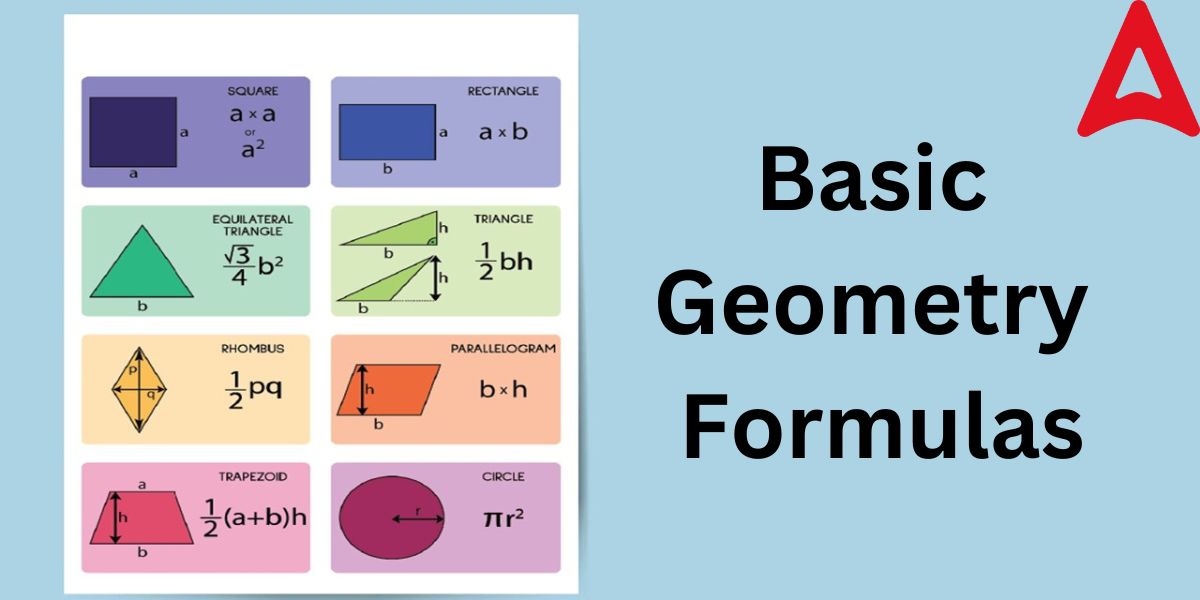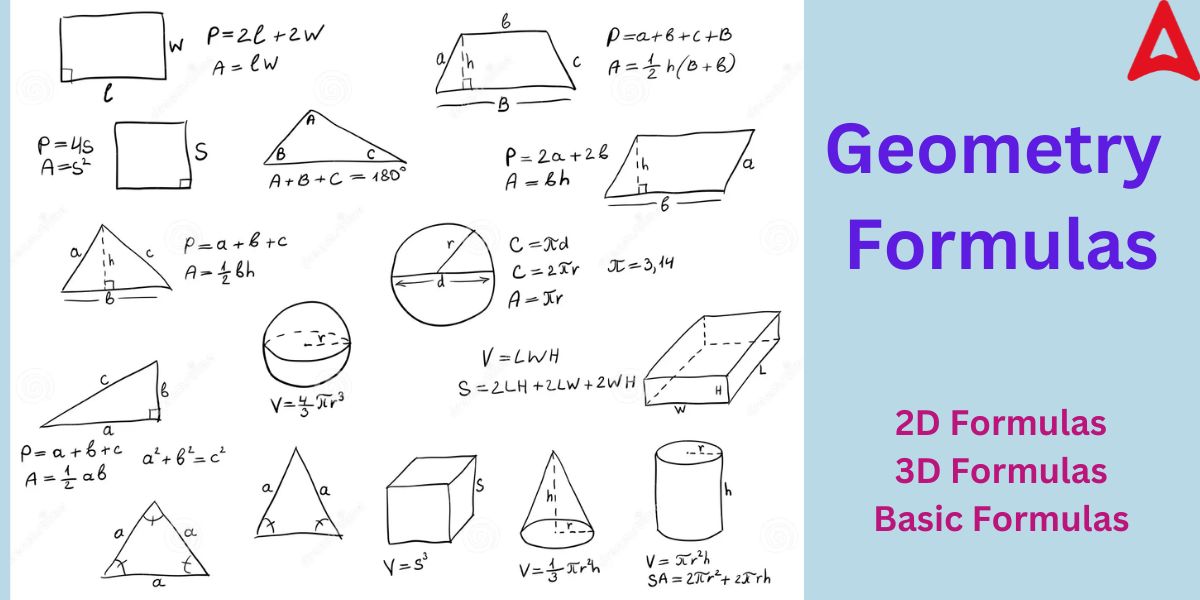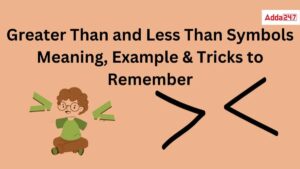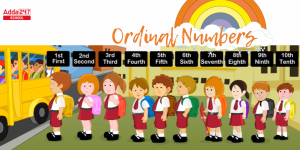Geometry formulas are used to find the dimensions and related properties like perimeter, area, and volume of geometrical shapes. These formulas are used extensively in different fields of science and technology. Observing the importance of the formulas of Geometry, it is taught to students from the early years of their school. In this article, we will cover all the formulas of 2D and 3D geometry along with basic geometry formulas for some basic shapes like triangles, squares, rectangles, etc. These formulas will not only be useful for students of class 10 and class 12 who will be taking board exams shortly but will also help aspirants prepare for competitive exams.
Geometry Formulas
The geometry formulas are used to find out different attributes of a geometrical shape. These attributes can be dimensions like length, breadth, or height (in case of 3D shapes), areas, perimeters, and volumes (in case of 3D geometrical figures). In mathematics, geometry is the study of relationships between points, lines, angles, surfaces, measurements of solids, and their properties. The branch of Geometry can be broadly classified into two categories: 2D Geometry (two dimensional geometry) and 3D Geometry (three dimensional geometry).
In 2D geometry, we study about the 2D shapes, i.e., two dimensional shapes. These geometrical figures have only two dimensions- length and breadth (width). So, we can only find the area and perimeter of these shapes but their volume cannot be determined because of the absence of the third dimension. Some examples of 2D geometrical figures are triangle, square, circle, rectangle, etc.
3D geometry deals with the study of three dimensional geometrical figures. These geometrical shapes have three dimensions – length, breadth (width), and height (also called depth or thickness). Due to the presence of the third dimension, we can compute the volume of 3D shapes using the geometry formulas apart from finding the area and perimeter. Some examples of 3D geometrical figures are cone, sphere, cylinder, cube, etc.
Geometry Formulas for Beginners
Looking at the significance of the geometrical formula in the real world calculations and architecture, students are taught these formulas from high school itself. Students from class 8th to class 10th study different geometrical formulas to calculate areas and volumes of 2D and 3D shapes. Some of the important geometrical formulas for the beginner students are given below.
Area Formula
- Area of Trapezium = height × (sum of parallel sides)/2
- Area of Rhombus = (1/2) × d1 × d2; where d1 and d2 are the two diagonals of the rhombus
- Area of Special Quadrilateral = (1/2) × d × (h1 + h2); where d is the diagonal, and h1 and h2 are the perpendiculars drawn on the diagonals from the vertices.
- Surface area of Cuboid = 2(lb + bh + hl); where l, b and h represent the length, breadth and height of the cuboid.
- Surface area of Cube = 6s2; where s represents the side of the cube.
- Surface area of cylinder = 2Πr(r + h); where h represents the height and r represents the radius of the cylinder.
- Area of an equilateral triangle = s²(√3/4), where s = side of the equilateral triangle
- Area of a regular hexagon = (3 x √3 x a²)/2, where a = side of the regular hexagon
Volume Formula
- Volume of Cuboid = l × b × h; where l, b and h represent the length, breadth and height of the cuboid.
- Volume of Cube = s3; where s represents the side of the cube.
- Volume of Cylinder = Πr2h; where h represents the height and r represents the radius of the cylinder.
- Volume of a Hollow Cylinder = Π. h(R² – r²), where R = outer radius, r = inner radius
- Volume of a normal square pyramid = (1/3) x h x s², where s = length of one of the sides of a square base and h is the height of the pyramid
Basic Geometry Formulas
The basic geometry formulas are important for every person whether they are preparing for the board exams or any other competitive exam. These formulas have applications in almost all the sector, ranging from engineering to statistics. Concepts regarding these formulas are even asked in the aptitude section of various government and private jobs. These basic formulas related to 2D and 3D geometrical figures are stated hereunder.
- Perimeter of a Square = 4 × Side
- Perimeter of a Rectangle = 2 × (Length + Breadth)
- Area of a Square = Side²
- Area of a Rectangle = Length × Breadth
- Area of a Triangle = ½ × Base × Height
- Area of a Trapezoid = ½ × (Base₁ + Base₂) × Height
- Area of a Circle = A = π × r²
- Circumference of a Circle = 2πr
- Curved Surface Area of a Cylinder = 2πrh
- Total Surface Area of a Cylinder = 2πr(r + h)
- Volume of a Cylinder = V = πr²h
- Curved Surface Area of a Cone = πrl
- Total Surface Area of a Cone = πr(r + l) = πr[r + √(h² + r²)]
- Volume of a Cone = V = ⅓ × πr²h
- Surface Area of a Sphere = S = 4πr²
- Volume of a Sphere = V = 4/3 × πr³
In all the above formulas,
h corresponds to height,
r corresponds to the radius,
l = slant height

2D Geometry Formulas
As we know, 2D geometrical figures are those figures that have only two dimensions. Knowing the formula to compute different attributes of these figures is highly important. For this purpose, below we have mentioned all the relevant 2D geometry formulas.
| 2D Shape | Area Formula | Perimeter Formula |
| Square | a² | 4a |
| Circle | π r² | 2πr |
| Rectangle | l × b | 2 ( l+ b ) |
| Triangle | ½ (b × h) | a + b + c |
| Right angle Triangle | ½ (b × h) | b + hypotenuse +h |
| Equilateral Triangle | √(3/4) × a² | 3a |
| Rhombus | ½ ×d1 ×d2 | 4 × side |
| Parallelogram | b × h | 2 ( l+ b ) |
| Trapezium | ½ h(a + b) | a + b + c + d |
3D Geometry Formulas
3D shapes are named so because they consist of three dimensions that are length, breadth and height. 3D shapes are found in the nature everywhere. So, to solve real-world problems, it is of utmost importance to learn these formulas. So, we have tabulated the most useful 3D geometry formulas below.
| Shape | Volume | Curved or Lateral surface area | Total surface area |
| Cube | a³ | 4a² | 6a² |
| Cone | (⅓) π r² h | π r l | Π r (r + l) |
| Cylinder | π r² h | 2π r h | 2πrh + 2πr² |
| Hemisphere | (⅔) π r³ | 2 π r² | 3 π r² |
| Cuboid | l × b× h | 2 h( l+ b ) | 2 ( lb+ bh+ hl ) |
| Sphere
|
(4/3) π r³ | 4 π r² | 4 π r² |
| Frustum of Cone | (1/3)Πh(R² + R. r + r²) | Π (R + r)l | π[(R + r)l+r²+R²] |
Geometry Formulas Solved Examples
To aware students with the application of these formulas in solving numerical, we have provided students with some solved examples on this topic.
Example 1: What will be the curved surface area of a cuboid whose dimensions are 5 m, 3 m, and 2 m.
Solution: Given the side of the dimensions of cuboid = 5 m, 3 m, 2 m
Hence, l = 5 m, b = 3 m, h = 2 m
as we know, curved surface area of a cuboid = 2 h( l+ b )
Hence, curved surface area of the cuboid = 2 x 2 (5 + 3)
= 32 m²
Example 2: Given a rectangular park with length of 80 meters and width of 50 meters, what is the area of the park?
Solution: Given,
The park is 80 meters long.
The park is 60 meters wide.
Utilizing the formulas for a rectangle in geometry,
Rectangle’s Area = (Length × Breadth)
= (80 x 50) square meters
= 4,000 square meters
The rectangular park has a total size of 4000 m².
Example 3: If the circle’s radius is 21 units, get the circumference and area of the circle using geometry formula.
Solution: To determine the circle’s area and circumference.
given the circle’s radius equals 21 units.
As we know, Circle area = π × r²
so, area = 3.142857 x 21²
= 1385.44 square units
Now we will find the circle’s circumference.
as we know, a circle’s circumference equals 2πr.
= 2(3.142857)(21)
= 131.95 units
The circumference of the circle is 131.95 units, while its area is 1385.44 square units.
Example 4: Determine the surface area and volume of a cube whose edge is six units using the cube’s geometry formulae.
Solution: Given the side of cube = 6 units
as we know, surface area of a cube = 6a², where a = side
Hence, surface area = 6²
= 36 square units
volume of a cube is given by a³, where a = length of the side of the cube
volume = 6³
so, volume of a cube = 216 cubic units











 Greater Than and Less Than, Equal to Sig...
Greater Than and Less Than, Equal to Sig...
 XXV Number- XXV Roman Numerals Definitio...
XXV Number- XXV Roman Numerals Definitio...
 Ordinal Numbers: Meaning, Examples, Appl...
Ordinal Numbers: Meaning, Examples, Appl...














